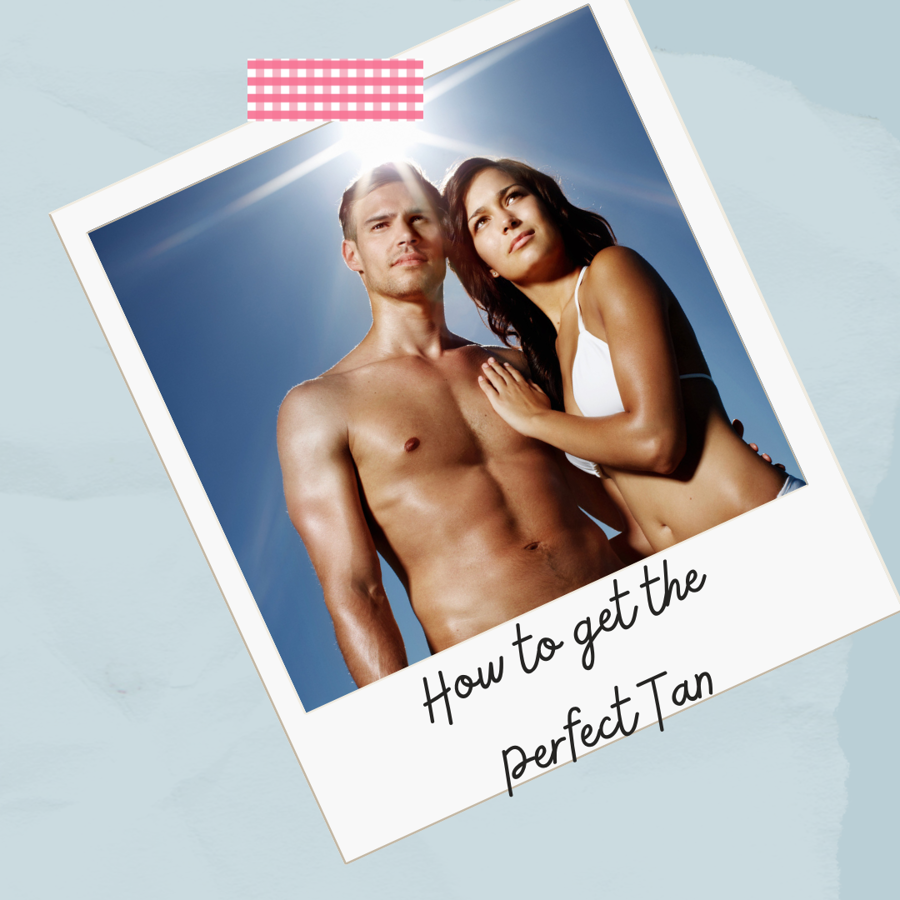
You've been eyeing up the perfect seamless, flawless tans that are being sported this summer; and you've been wondering how you can achieve that same perfect tan.
You know they can't be wearing a spray-tan, or applied a self tan; as there are no tell tale signs of wear around the feet, dry patches on ankles, missing areas on the back where self tan couldn't be applied or the Orang-a-tan look on the backs of their hands.
Which brings you back to.......... "What's their Tanning Secret?"
Questions running through your head are .......
- Did they really just get their tan sun-bathing in the sun?
- Are they taking nasal sprays, injections or additional supplements to get that deep tan?
- Are they just pros at applying their fake tan?
- Do they know the most fantastic spray-tan technician in town?
- Do they UV tan?
Well, the answers to all those questions are "Yes" to some degree! The Secret to getting the Perfect Tan is a combination of some, if not all of the above.
If you want to know the most effective way to achieve an all over, year long tan; then read on. I promise you, that by following 6 easy steps you can, and will achieve the tan of your dreams.
Step 1 - Identify your Skin Type
Knowing your skin type will help you determine:
a) whether your skin is capable of tanning; and
b) what considerations you should give to your skin type
There are 6 universal skin types that are used to assess tanning and beauty in general (including colour matching for cosmetic products).

Skin Type 1
This skin type tends to burn and never tans. People with skin type 1 typically have red hair, white, pale complexions, with light blue or light green eyes and may have freckling. This skin type is not recommended to be exposed to sunlight when Ultraviolet A and Ultraviolet B (UVA/UVB) is at it's harshest; nor should they use a sunbed. In New Zealand the Ministry of Health recommends that all skin type ones cannot use a sunbed.
Your perfect colour will need to come from spray tanning or self tanners. Knowing your skin type will assist with determining the correct colour base to choose, depending on the the depth of colour you want to achieve.
There are also melanin products available that can assist in colour boosting, however you should ensure you undertake proper investigation of these products as some are unsafe.
Skin Type 2
People with this skin type are typically blonde haired, with blue, green or hazel eyes, with pale complexions; that when in the sun, tend to burn easily. They may have freckles. They can tan but will need to tan slowly and they may find that the tan fades quickly.
Skin Type 3
This skin type is the most common and will tan easily, but to keep the tan they will need to keep up a tanning regimen. Typically a person with this skin type will have brown to dark hair, any eye colour, and present with little to no freckes. This skin type can still burn and is often the skin type that tends to suffer from "Farmers Tan". This is where there are multiple different shades of tan across the body due to the shapes of clothing being worn while exposed to the sun. Brides beware of Farmers Tan!
This skin type typically is the group that should get a base tan before exposing to more UVA/UVB rays prior to going on holiday and are the group that wants to keep their holiday tan when they achieve it.
Skin Type 4
You may wonder why skin types 4-6 might want to tan, since in your opinion they have a natural lovely colour. This is typically due to the fact that their melanin colour fades just like the rest of us. I have Italians and Maori that when not able to get in the sun - especially in winter; their colour starts to fade and they just want that feel good, melanin poppin, good vibe they get when they look good.
Skin Type 5
Typically this person would have dark brown or black hair with brown eyes and may have Indian or African heritage.
Skin Type 6
The darkest skin type - where people have very dark or black skin. They have dark brown eyes and black hair and rarely burn. The melanin is dense in order to protect their skin from the harsh UVA/UVB rays, and as such tend to suffer from photo-aging at a much slower rate than the other skin types.
Your tanning technician will be able to fully assess your skin, asking questions about cancer within the family, use of photo sensitive skin products (retinol) and photo sensitive prescription drugs. They will also discuss any tanning goals; for example are you tanning for a special event coming up like a wedding or a holiday. They can then assess timeframes for you to achieve the look.
Step 2 - Prepare you skin
Now you know you skin type, you are ready to tan. You've heard it multiple times; whether you want a spray tan, or use a self tanning product - you need to prepare your skin. The same is true if you want to use a sunbed.
- Wax or shave at least 1 whole day prior to tanning (if not 2 days prior).
Why? Because wax leaves residue on the skin and this residue needs to be fully removed otherwise it will create a barrier between the product you are applying, whether spray tan, self tan or tanning accelerators or maximisers for use on the UV bed. Shaving heads often have moisturising strips and these will leave a barrier on your skin. Shaving is also abrasive and can remove skin, leaving raised dots on the skin. This skin is dry and so spray tan and self tanners will grip more firmly on these areas, leaving noticeable spots on your legs.
- Exfoliate - remove all old skin.
Skin cells turn over about every 28 days, so if you don't exfoliate old skin, the layers will build up and skin will flake off in patches. If you apply products over this skin, when skin eventually sloughs off you will be left with patchy, tiger bread skin.
- Moisturise the night prior to applying products.
Products apply and last longer on hydrated, moisturised skin. Do not apply the morning of, or prior to applying products or having a UV sunbed session. Some products do not absorb easily so will leave residue on your skin and create a barrier, this will mean that your product will not last long. Moisturisers can damage the acrylic on sunbeds so only use UV specialised products that come with hydrating and moisturising properties that ensure photo-aging is minimised.
Step 3 - Be Consistent with Scheduling Tanning Time
So you want to get your tan the good ole fashioned way - sitting out in the sun. Ok, you can do that. If you know your skin type you will know that if you are a Skin Type 1 you should not expose yourself as the likelihood of burning is guaranteed. If you are one of the other skin types you can sit in the sun, but you will need to do this in small, short bursts. UVA/UVB rays a stronger at different times of the day, however this is also dependent on what continent you live on - whether you are closer or further away from the sun. If you do plan on sitting in the sun, I would suggest that you use an outside tan accelerator so that you get results faster without having to remain in the sun any longer than you need to.
To get a tan in a controlled environment such as a solarium, it takes 4-6 weeks coming 2-3 times per week to get a base tan if you are starting from scratch. Higher skin types may tan faster, however what is important is that you need to schedule in time to keep the tan building. Coming in 2-3 times the first week and then coming in once every week or two will not build that tan up.
Tanning accelerators/maximisers can greatly decrease the time to get a tan and you can select a product based on the depth of colour you want to achieve. These products have been created so that they stimulate the melanin production within your skin.
A tanning technican can create a tanning timetable for you to keep you on track.
Step 4 - Nourish & Maintain skin health
Whether you prefer to tan indoors or outdoors or get a spray tan or use self tanners, you should always keep your skin hydrated and moisturised. Keeping your skin hydrated and moisturised reduces the aging process and ensures skin elasticity continues while being exposed to environmental factors.
To extend the life of your tan, whether it is a sunless tan or not, you should swap your normal moisturiser for a tan extender. Some tan extenders have bronzing properties which will continue to build on the colour that you have, or they may just extend the life of your spray tan from 7 days to 10 days. These are great products to use when you can't get to your sun bed session or you are now away on holiday.
Beach holidays will wear off sunless tans around your feet and your body if you are swimming in the ocean. To ensure you don't get any patchiness you want to use an extender or gradual tanner at least every 2 days, if not daily. I recommend using a buffing brush to buff in gradual tanners or colours onto the feet to keep them looking good.
You should always apply sun screen when out in the sun to reduce the effects of photo-aging from the sun, this includes wearing lip protection.
Step 5 - Change it Up
You can hit a tanning plateau. No matter how often you tan, your colour is just not getting any deeper.
There are a couple of things you can try:
- Change the bed or stand-up you are using
Don't keep using the same bed or stand up. Try a different one. Keep swapping it up for a couple of weeks
- Change or start using a tan accelerator
Sometimes our bodies get used to the same products and so it stops reacting to it the way it used to. Changing the lotion should put you back on track.
- Cocktail Tan - after having a tanning session your pores will be open, now jump into a spray tan booth. That tan will settle deeper into your skin and give you the tan you want while waiting for your melanin to start poppin to the surface of your skin. Now lock that colour all in the next day with a tan extender.
Step 6 - Boost your melanin production
Make the most of the great tanning products out there. There are now products that can be used in doors and out doors that will continue to boost your tan, usually triggered by UV rays. Products that contain Carrot Root or Carrot Oil contain the strongest natural tanning ingredient so are always great to use, whether in a tanning product or in a drink or capsule.
I recommend staying away from nasal sprays as damage can be done to the delicate membranes of the nose. Even using atomisers for blocked noses can only be used for a short period before having to stop usage. The use of injections comes with hygiene issues, where have these come from and do you know how to inject yourself. The danger just isn't worth taking the risk.
It is always important to read up on the ingredients in oral products to ensure you keep your health and wellness at the forefront of any decisions you make when cosmetically tanning.
To book a tanning consultation session select Intro Session, or just book a sunbed or stand up capsule Make a Booking
To purchase any tanning preparation products or UV accerators/maximisers or self tan and extenders go to the shop Go shopping

